Geothermal energy: how the Earth’s heat was turned into an efficient energy resource
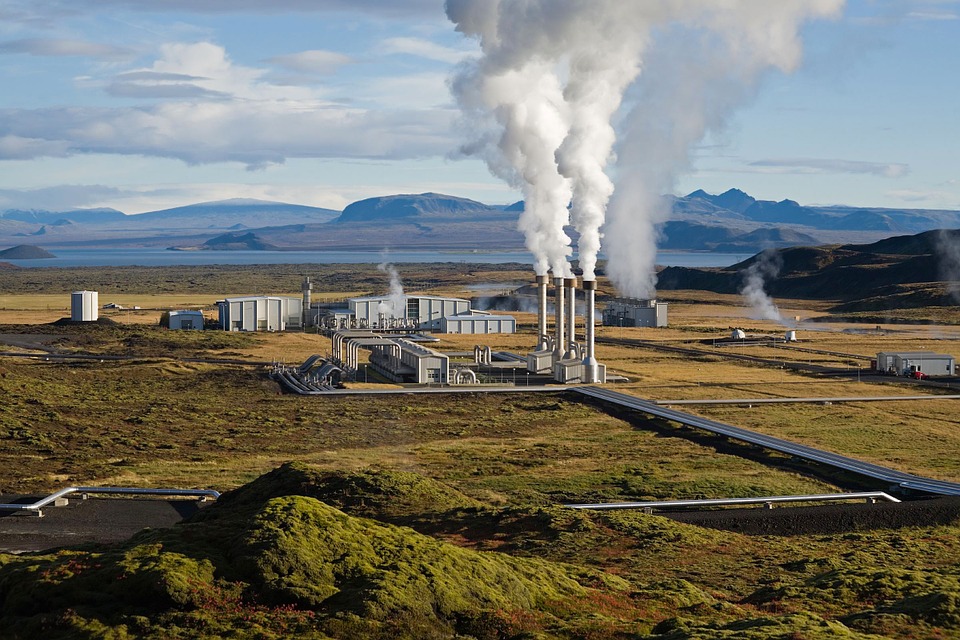
Given: there is a hot core inside the Earth, with it you need to generate electricity.
Question: how to do this?
Answer: build a geothermal power station.
We figure out exactly how, from where underground the steam comes from and how much benefit there is from such a power plant.
The oldest and most popular method for producing electricity on an industrial scale today is the rotation of the generator turbine with a powerful stream of hot steam from boiling water due to forced heating. If you think about it, the essence of the work in a coal thermal power plant and in a modern nuclear power plant is boiling water, with the only difference being that coal is burned for this purpose, and in the reactor of a nuclear power plant it is boiled by heating elements that are heated as a result of a controlled chain reaction.
But why heat water if in some places it comes out of the ground already hot? Is it possible to use it directly? You can: in 1904, Italian Pierrot Ginori Conti launched the first generator, powered by a pair of natural geothermal sources, abundantly present in Italy. So the first geothermal power station in the world appeared, which still works.
However, in order to provide the geothermal power plant with acceptable efficiency and cost, you need water of a certain temperature, not deeper than a certain level. If you want to build a geothermal power plant (say, in your summer cottage), you first have to start drilling wells to aquifers, where water under great pressure heats up to 150-200 ° C and is ready to come to the surface in the form of superheated boiling water or steam. Well, then, like fossil fuel power plants, incoming steam will rotate a turbine that will drive a generator that generates electricity. Use the natural heat of the planet to produce steam - this is geothermal energy. And now for the details.
A little bit about the warmth of the Earth
The surface temperature of the Earth’s solid core at a depth of about 5100 km is approximately 6000 ° C. When approaching the earth's crust, the temperature gradually decreases.

A clear graph of rock temperature changes as you move toward the center of the earth. Source: Wikimedia / Bkilli1
The so-called geothermal gradient - a temperature change in a specific area of the earth's thickness - averages 3 ° C for every 100 meters. That is, in a mine at a depth of 1 km there will be a thirty-degree heat — anyone who has visited such a mine will confirm this. But depending on the region, the temperature gradient changes - for example, in the Kola superdeep well at a horizon of 12 km, a temperature of 220 ° C was recorded, and in some places of the planet, near tectonic faults and zones of volcanic activity, to achieve similar temperatures, it is enough to drill from several hundred meters up to several kilometers, usually from 0.5 to 3 km. In the US state of Oregon, the geothermal gradient is 150 ° C per 1 km, and in South Africa only 6 ° C per 1 km. Hence the conclusion: you cannot build a good geothermal station anywhere (before starting work, make sure that your summer cottage is in a suitable place). As a rule, suitable places are those where there is strong geological activity - earthquakes often occur and there are active volcanoes.
Types of geothermal power plants
Depending on which geothermal energy source is available (say, in your DSC), you will choose the type of power station. We will understand what they are.
Hydrothermal station
A simplified diagram of a direct cycle hydrothermal power plant will be clear even to a child: hot steam rises from the ground through the pipe, which spins the generator’s turbine, and then rushes into the atmosphere. It's really that simple if we are lucky to find a suitable source of steam.

GeoTES direct cycle. Source: Save On Energy
If the steam you have available does not beat steam, but steam-water mixtures with temperatures above 150 ° C, then a combined cycle station will be required. In front of the turbine, the separator will separate the steam from the water - the steam will go to the turbine, and the hot water will either be discharged into the well or transferred to the expander, where under low pressure it will give off additional steam for the turbine.
If your holiday village is not lucky with hot springs - for example, if the temperature of the underground water is less than 100 ° C at an economically acceptable depth - and you really want to have a GeoTES, you will need to build a complex binary geothermal stationwhose cycle was invented in the USSR. In it, the liquid from the well is not supplied to the turbine at all in any form. Instead, in a heat exchanger, it heats another working fluid with a lower boiling point, which, turning into steam, spins the turbine, condenses, and returns to the heat exchange chamber. Such working fluids may be, for example, freon, one of which species (fluorodichlorobromomethane) boils even at 51.9 ° C. The binary cycle can be combined with the combined one, when steam will be supplied to one turbine, and the separated water will be sent to another circuit to heat the coolant with a low boiling point.
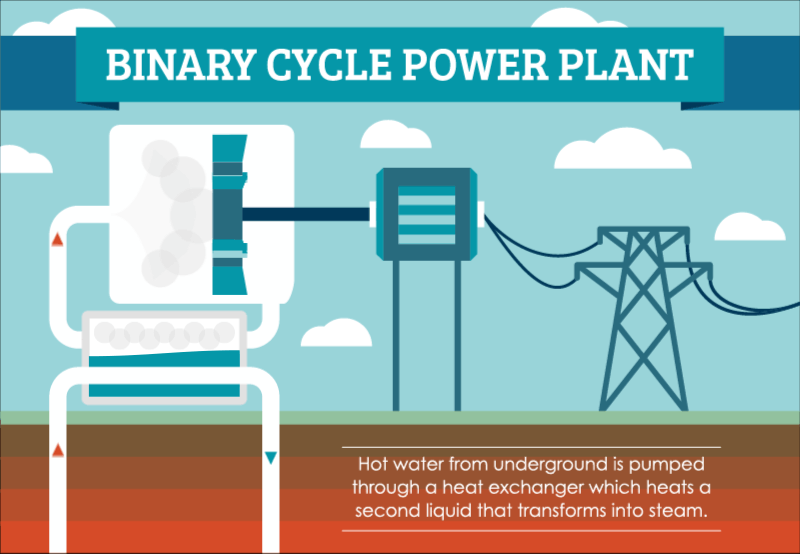
GeoTES binary cycle. Source: Save On Energy
Petrothermal Station
Heated underground sources are a very rare phenomenon on a planetary scale, as you probably could notice, which severely limits the potential area for the introduction of geothermal energy, so an alternative approach was developed: if there is no water in the hot depths of the earth’s crust, then it needs to be pumped there. The petrothermal principle involves the injection of water into a deep well with heated rock, where the liquid turns into steam and returns back to the turbine of the power plant.

Simplified scheme of a petrothermal power plant
It is necessary to drill at least two wells: water will be supplied to one from the surface so that the heat of the rocks will turn into steam and exit through another well. And then the process of generating electricity will be completely similar to the hydrothermal station.
Naturally, it is unrealistic to connect two wells underground at a depth of several kilometers - the water between them is connected due to fractures resulting from pumping fluid under tremendous pressure (hydraulic fracturing). To prevent crevices and voids from closing over time, granules, for example sand, are added to the water.
On average, one well for a petrothermal process produces a steam-water mixture flow sufficient to generate 3-5 MW of energy. So far, such systems have not been implemented anywhere at the industrial level, but work is ongoing, in particular, in Japan and Australia.
The benefits of geothermal energy
From the foregoing, it follows that the use of Earth's heat to generate electricity on an industrial scale is not cheap. But very beneficial for a number of reasons.
Inexhaustibility.Power plants using fossil fuels - natural gas, coal, fuel oil - are highly dependent on the supply of this same fuel. Moreover, the danger lies not only in the cessation of supplies due to disasters or changes in the political situation, but also in an unplanned spasmodic increase in raw material prices. In the early 1970s, due to political turbulence in the Middle East, a fuel crisis erupted, leading to a fourfold increase in oil prices. The crisis gave a new impetus to the development of electric transport and alternative types of energy. One of the advantages of using earthly heat is its practical inexhaustibility (as a result of human actions, at least). The annual heat flux of the Earth to the surface is about 400,000 TW · h per year, which is 17 times more than during the same period all the world's power plants produce. The temperature of the Earth’s core is 6000 ° C, and the cooling rate is estimated at 300-500 ° C for 1 billion years. Do not worry that humanity is able to accelerate this process by drilling wells and pumping water there - a drop in the core temperature by 1 degree releases 2 · 1020 kWh of energy, which is millions of times more than the annual consumption of electricity by all mankind.
Stability. Wind and solar power are extremely sensitive to weather and time of day. There is no sunlight - there is no generation, the station gives up a reserve of batteries. The wind has weakened - again there is no production, again batteries with by no means infinite capacity come into play. Subject to the technical processes for the return of water to the well, the hydrothermal power plant will continuously operate 24/7.
Compactness and convenience for difficult areas.Powering remote areas with isolated infrastructure is not an easy task. It is even more complicated if the area has poor transport access, and the terrain is not suitable for the construction of traditional power plants. One of the important advantages of geothermal power plants is their compactness: since the coolant is literally taken from the ground, a turbine room and a generator and a cooling tower are built on the surface, which together take up very little space.
A geothermal station with a generation of 1 GW · h / year will occupy an area of 400 m2 - even in the highlands of a geothermal power station, a very small area and a highway will be required. For a solar station with the same output, 3240 m2 will be required, for a wind station - 1340 m2.
Environmental friendliness.The operation of the geothermal station itself is practically harmless: its carbon dioxide emission into the atmosphere is estimated at 45 kg of CO2 per 1 kWh of generated energy. For comparison: at coal stations, the same kilowatt-hour accounts for 1000 kg of CO2, at oil stations - 840 kg, gas - 469 kg. However, nuclear plants account for only 16 kg - something, and they produce a minimum of carbon dioxide.
The possibility of parallel mining.Surprisingly, it is a fact: in some power units of GeoTES, in addition to electricity, they also produce gases and metals dissolved in a steam-water mixture coming from underground. They could simply be put back into the well together with the spent condensed steam, but, given the volumes of useful elements that pass through the geothermal power station, it would be more reasonable to set up their production. In some areas of Italy, steam from wells contains 150-700 mg of boric acid per kilogram of steam. One of the local hydrothermal power plants at 4 MW consumes 20 kg of steam per second, so the production of boric acid there is put on an industrial basis.
Disadvantages of geothermal energy
The working fluid is dangerous. As noted above, Geo-TPPs do not produce additional toxic emissions, only a small amount of carbon dioxide, an order of magnitude smaller than that of gas-fired TPPs. Which, however, does not mean that groundwater and steam are always pure substances, akin to mineral drinking water. The steam-water mixture from the depths of the earth is saturated with gases and heavy metals that are characteristic of a specific part of the earth's crust: lead, cadmium, arsenic, zinc, sulfur, boron, ammonia, phenol, and so on. In some cases, such an impressive cocktail flows through the pipes to the GeoTES that its discharge into the atmosphere or water bodies will immediately cause a local environmental disaster.
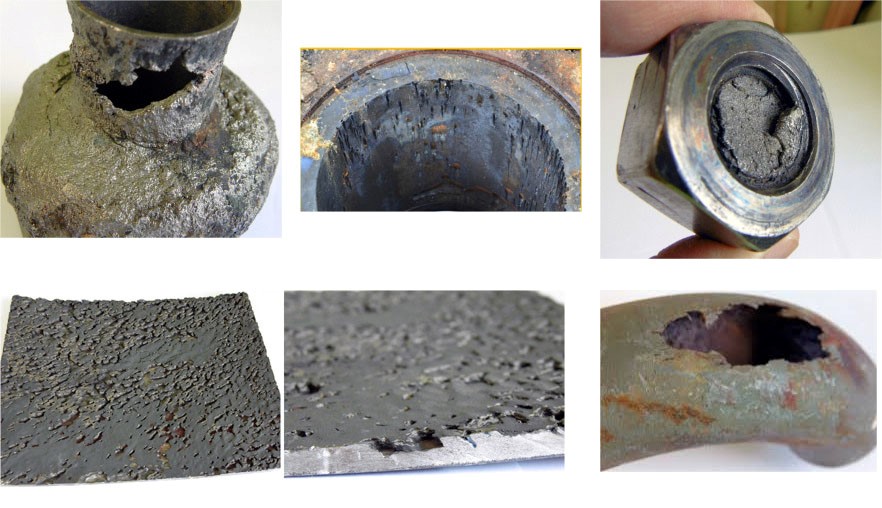
The result of the action of geothermal water on metals.
Subject to all safety requirements, the steam sent to the atmosphere is carefully filtered from metals and gases, and the condensate is pumped back into the well. But in case of emergency situations or intentional violation of technical regulations, a geothermal station can cause some damage to the environment.
High cost per kilowatt.Despite the relative simplicity of the design of the GeoTES, the initial investments in their construction are considerable. A lot of money is spent on exploration and analysis, as a result of which the cost of geothermal stations fluctuates at the level of $ 2800 / kW of installed capacity. For comparison: TPP - $ 1000 / kW, wind turbines - $ 1600 / kW, solar power plant - $ 1800-2000 / kW, nuclear power plant - about $ 6000 / kW. Moreover, the average cost is given for GeoTES, which can vary greatly depending on the country, topography, chemical composition of steam and drilling depth.
Relatively low power. Geo-TPPs, in principle, cannot yet be compared in terms of generating electricity with hydroelectric power plants, nuclear power plants and thermal power plants. Even when drilling a large number of wells, the steam flow will still be small, and the electricity generated will be enough only for small towns.
The most powerful The Geysers geothermal power complex for 2019 is spread over an area of 78 km2 in California, USA. It consists of 22 hydrothermal stations and 350 wells with a total installed capacity of 1,517 MW (actual production of 955 MW), which cover up to 60% of the energy requirements of the northern coast of the state. The total capacity of The Geysers is comparable to the Soviet RBMK-1500 reactor, which once worked at the Ignalina NPP, where there were two, and the NPP itself was located on an area of 0.75 km2. Geothermal power plants with a generation of 200-300 MW are considered very powerful, while most stations around the world operate with double-digit numbers.
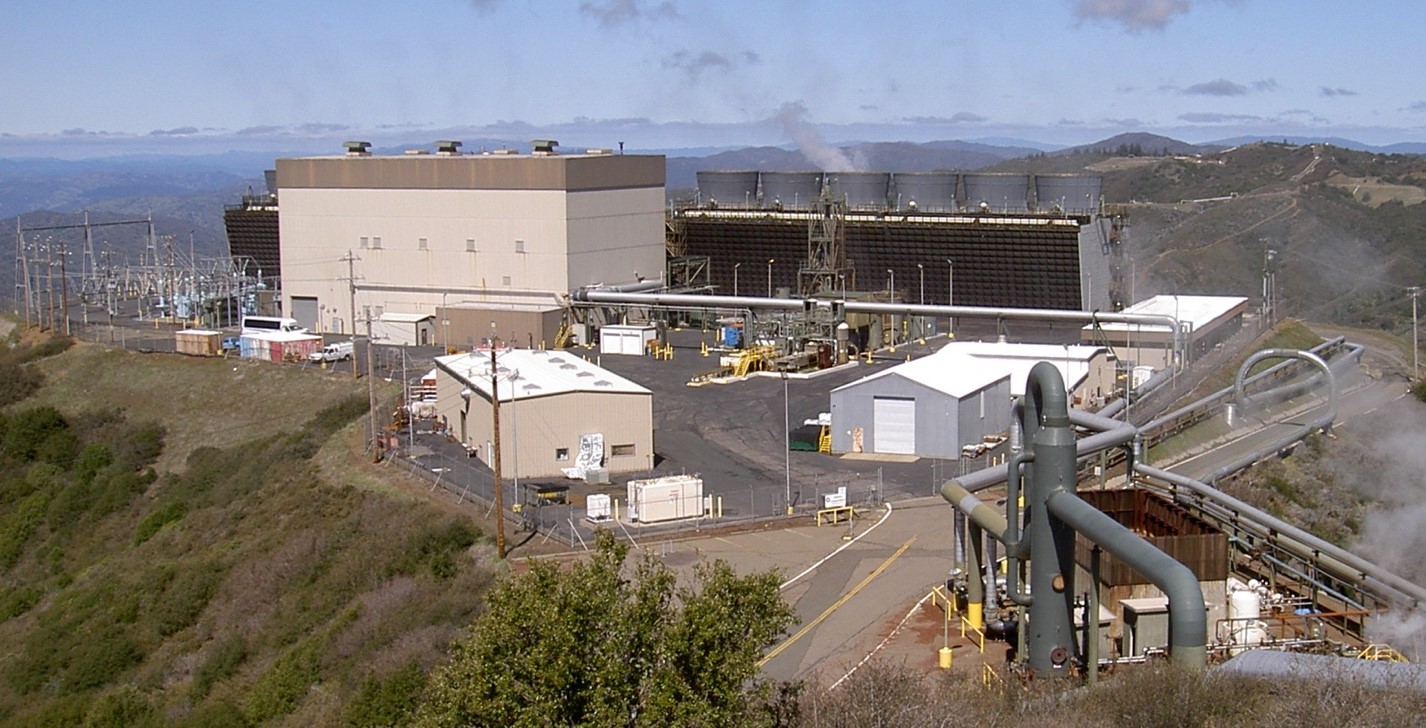
The hydrothermal combined station of The Geysers complex in California. And there are 22 of them. Source: Wikimedia / Stepheng3
Where does it all work and how promising is it
As of 2018, geothermal power plants around the world generate more than 14.3 GW of energy, while in 2007 they produced only 9.7 GW. Yes, not a geothermal revolution, but growth is evident.
The leader in geothermal production is the United States with its 3,591 MW. Impressive value, which, however, is only 0.3% of the country's total output. Next comes Indonesia from 1948 MW and 3.7%. But in the third place, the interesting begins: in the Philippines, geothermal power plants have an installed capacity of 1868 MW, while they account for 27% of the country's electricity. And in Kenya - 51%! Japan is also among the top ten in terms of the number of kilowatts generated by the Geo-TPP.
The first geothermal power station, Matsukawa, opened in Japan in 1966. It generated 23.5 MW, and Toshiba produced the turbine and generator for it. In the 2010s, geothermal energy became the most demanded in the countries of Africa, where the active conclusion of contracts and the construction of GeoTPS began. In 2015, Kenya opened the Olkaria IV station, one of four, located in the Olkaria area 120 km from Nairobi, with a capacity of 140 MW. With its help, the government reduces its dependence on hydroelectric power plants, the discharge of water from which often leads to devastating floods.
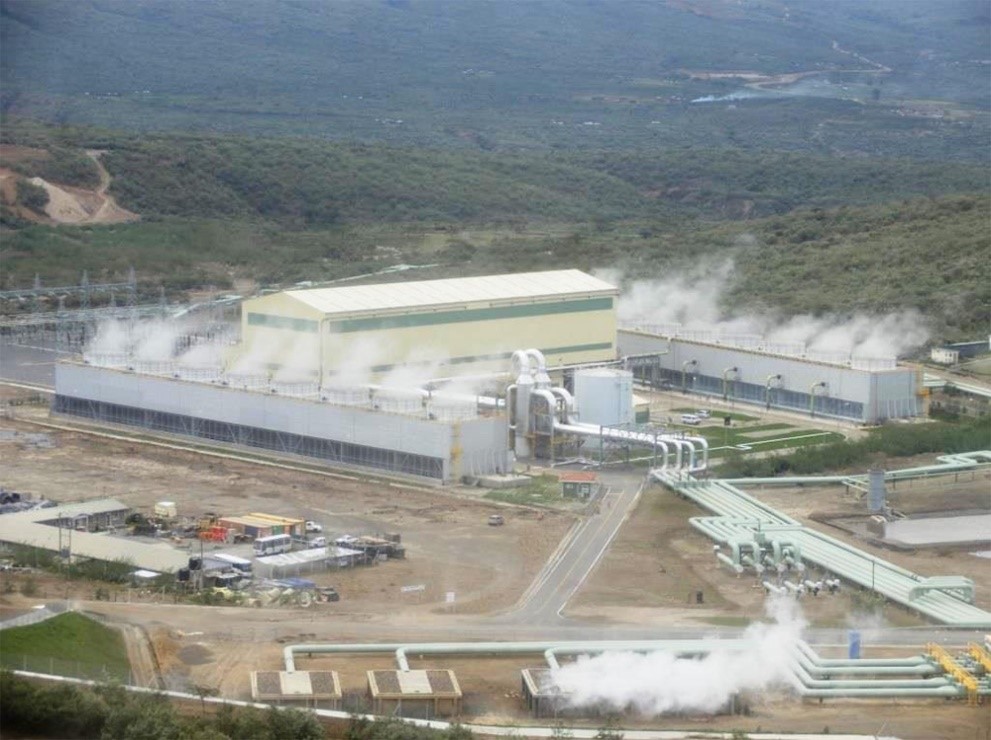
GeoTES Olkaria IV in Kenya. Olkaria V and Olkaria VI plan to be commissioned in 2021. Source: Toshiba
Geo-TPPs are also being actively built in Uganda, Tanzania, Ethiopia and Djibouti.
In Russia, the development of geothermal energy is proceeding at a very leisurely pace, since there is no special need for the construction of additional power plants. In 2015, such stations accounted for only 82 MW.
The Pauzhet geothermal station, built in Kamchatka in 1966, was the first in the USSR. Its initial installed capacity was only 5 MW, now it has been brought up to 12 MW. After it, the Paratunskaya station with a capacity of only 600 kW appeared - the first binary GeoTES in the world.
Now in Russia there are only four stations, three of them feed Kamchatka, one more, 3.6 MW Mendeleev GeoPP, supplies the Kunashir island of the Kuril ridge.
There are many ways to generate electricity on our planet without the help of fossil fuels. Some of them, for example, solar and wind energy, are successfully used now. Some, like hydrogen fuel cells, are still at the initial stage of adaptation. Geothermal energy is our foundation for the future, the full potential of which we have yet to unleash.
